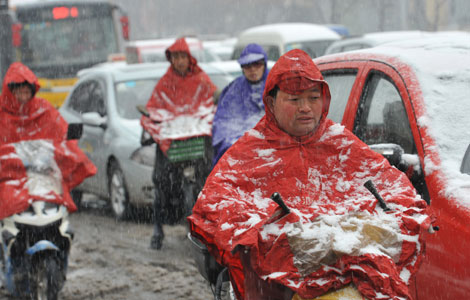White paper clears illusions
Updated: 2013-04-23 08:12
By Liu Qiang (China Daily)
|
||||||||
The white paper on national defense, "Diversified Employment of China's Armed Forces", which Beijing issued on April 16, is different from the previous seven ones because it covers every related subject. The white paper is informative and succinct, and offers compelling answers to questions on why China should develop its armed forces, and what it is composed of and committed to. These changes manifest China's higher level of transparency and growing confidence in matters of national defense.
A highlight of the latest defense white paper is its modified structure. Its main body of five chapters has been distilled from 10 of the earlier white papers. It starts with a layout of the security landscape China faces at home and beyond, the emerging security challenges and the defense policies and principles its armed forces adhere to. This is followed by a detailed account of the structure of the armed forces, and an elaboration of the three major tasks undertaken by them in three chapters.
The white paper for the first time illustrates the structure of the armed forces by revealing the actual number of army, navy and air force personnel, and the designations of the combined army corps under the seven military area commands as well as the main missile lineup.
Although this, to a great extent, refutes some countries' accusation that China lacks transparency when it comes to its military, "China threat" theorists still say the white paper does not disclose the exact number of personnel that make up the secondary artillery force, the arm of the People's Liberation Army in charge of nuclear and conventional missiles.
There is no uniform standard for military transparency. And the delicate nature of military information means that there will not be full disclosure, which applies to all countries. Every country has its special law and regulation on military secrets. So accusing China of not giving full information on its missile force is not only unfair, but also a blatant disregard of its efforts to improve military transparency.
The latest white paper excels the previous ones in its account of the diversified employment of the armed forces. It says the armed forces are employed to fulfill three major goals: defend national sovereignty, security and territorial integrity; support national economic and social development; and safeguard national maritime rights and interests as well as world peace and regional stability.
China needs the armed forces to not only ensure national security and stability, but also to safeguard world peace and regional stability, which proves that the country is fulfilling more international duties as a major responsible power.
Another highlight of the defense white paper is its positioning of the second artillery force as "a core force of China's strategic deterrence" - primarily responsible for deterring other countries from using nuclear weapons against China and carrying out nuclear counterattacks and precision strikes with conventional missiles.
According to the white paper, if China faces a nuclear threat, the nuclear missile force will act upon the orders of the Central Military Commission, go into a higher level of readiness and prepare for a nuclear counterattack to deter the enemy. But if China comes under a nuclear attack, the nuclear missile force will launch a nuclear counterattack either independently or together with the nuclear forces of other services. The conventional missile force, capable of shifting instantly from peacetime to wartime readiness, will conduct conventional medium- and long-range precision strikes.
In fact, the white paper issued in 2011 also mentioned the second artillery force's capability as a strategic deterrence unit along with its other capabilities, including rapid reaction, penetration and precision striking power, though its emphasis was not on strategic deterrence.
The latest white paper, however, explicitly says the second artillery force is the core strategic deterrence force. The repeated mention of "counterattack" in the white paper reflects the country's stance on the use of nuclear weapons: China will not attack unless it is attacked, but China will definitely counterattack if attacked. The white paper also sends out a message to the rest of the world, that China will tread the path of peaceful development and unswervingly pursue a defense policy that is defensive in nature.
Embodying the thoughts and strategic confidence of the new leadership, the white paper shows China's determination to defend national security and willingness to work with other countries to maintain world peace and boost mutual trust and cooperation.
Openness, pragmatism, confidence and willingness for cooperation are the defining features of the latest defense white paper, which demonstrate China's military transparency and refute the "China threat" theory.
The author is a senior colonel and a professor at the International Security Research Center, International Studies University of PLA.
(China Daily 04/23/2013 page9)

 Obama celebrates young inventors at science fair
Obama celebrates young inventors at science fair
 Earth Day marked around the world
Earth Day marked around the world
 Volunteer team helping students find sense of normalcy
Volunteer team helping students find sense of normalcy
 Ethnic groups quick to join rescue efforts
Ethnic groups quick to join rescue efforts
 Earthquake leaves family shattered
Earthquake leaves family shattered
 Boston Marathon bombing suspect charged
Boston Marathon bombing suspect charged
 Chasing vestiges of the Great Wall
Chasing vestiges of the Great Wall
 Weekly Photos: April 15-21
Weekly Photos: April 15-21
Most Viewed
Editor's Picks

|

|

|

|

|

|
Today's Top News
Russia criticizes US reports on human rights
China 'aims to share its dream with world'
Chinese president appoints 5 new ambassadors
Nation's IPR suits see spike in 2012
H7N9 not spread between humans: WHO
Health new priority for quake zone
Sino-US shared interests emphasized
China, ROK criticize visits to shrine
US Weekly

|

|






